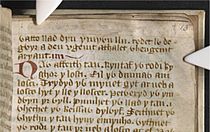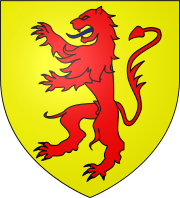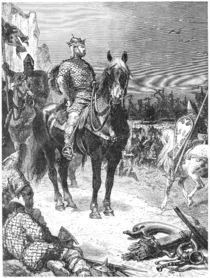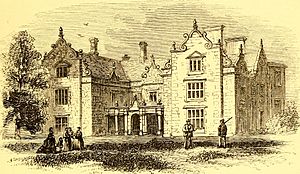Bleddyn ap Cynfyn facts for kids
Quick facts for kids Bleddyn (Blevins)ap Cynfyn |
|
|---|---|
| King of Powys (also Gwynedd) "Chiefest of the Britons" | |
| Died | 1075 |
| Spouse | Haer ferch Gillyn |
| Father | Cynfyn ap Gwerystan |
| Mother | Angharad ferch Maredudd ap Owain |
Bleddyn ap Cynfyn (Old Welsh: Bledẏnt uab Kẏnỽẏn; d. AD 1075), sometimes spelled Blethyn, was an 11th-century Welsh king. King Harold Godwinson and Tostig Godwinson installed him and his brother, Rhiwallon, as the co-rulers of Gwynedd on his father's death in 1063, during their destruction of the kingdom of their half-brother, king Gruffydd ap Llywelyn. Bleddyn became king of Powys and co-ruler of the Kingdom of Gwynedd with his brother Rhiwallon from 1063 to 1075. His descendants continued to rule Powys as the House of Mathrafal.
Contents
Background
Bleddyn was born to a poorly documented Powys nobleman named Cynfyn ap Gwerystan, known only from the late traditional pedigrees reporting Bleddyn's parentage. Cynfyn's claimed father, Gwerstan or Gwerystan, is given contradictory Welsh pedigrees consisting mostly of otherwise unknown names, a possibly spurious derivation since his name perhaps actually represents a rendering of the Anglo-Saxon name Werestan.
Cynfyn, likely a supporter of king Llywelyn ap Seisyll, would after the latter's 1023 death marry the widowed queen, Angharad, daughter of King Maredudd of Dyfed, member of the House of Dinefwr, whose realm had been lost to the Irish pretender Rhain before its conquest by Llywelyn.
Angharad and Cynfyn had at least two sons, Bleddyn and Rhiwallon, probably born in the late 1020s, who were thus maternal half-brothers of Gruffydd ap Llywelyn, Angharad's son by her first husband. Gruffydd, aged about ten and passed over for succession at the time of his father's death, slowly rebuilt his father's realm, annexing its successor states.
Cynfyn and Rhiwallon first appear in the documentary record in 1063. Bleddyn may have been residing in Powys, where he married Haer ferch Cillyn, daughter of the Lord of Gest Cillyn y Blaidd Rudd ("Cillyn the Red Wolf").
Reign
Gruffydd's consolidation of power and alliance with earl Ælfgar of Mercia made him a threat to king Harold Godwinson, earl of Hereford. Upon Ælfgar's death in 1060, Harold and his brother Tostig quickly invaded; the following year, they invaded again and were left in mastery of Wales after traitors among his men killed Gruffydd during a retreat. The south was restored to the Houses of Dinefwr and Morgan, but Powys and Gwynedd were given to Gruffydd's half-brothers Bleddyn and Rhiwallon. These two submitted to Harold and swore themselves vassals and allies of Edward the Confessor.
At the time of the Norman Conquest, Bleddyn was the most powerful king in Wales. Closely allied with Harold, the brothers joined the Saxon resistance to William the Conqueror following his conquest of England. In 1067, they joined the Mercian Eadric the Wild in their struggle against William and attacked the Normans at Hereford, ravaging the lands as far as the River Lugg. In 1068, they joined earls Edwin of Mercia and Morcar of Northumbria in their attacks as well. The earls both later submitted to William.
In 1070, king Gruffydd's sons, Idwal ap Gruffydd and prince Maredudd ap Gruffydd, challenged Bleddyn. Rhiwallon, Idwal and Maredudd all died in the Battle of Mechain. Bleddyn was the king of both Gwynedd and Powys.
In 1073, Robert of Rhuddlan stealthily established his forces on the banks of the River Clwyd and attempted to ambush and capture Bleddyn. He narrowly failed, but seized valuable booty in raids further south. Bleddyn was killed in 1075 by King Rhys ab Owain of Deheubarth, having been betrayed by the lords of Ystrad Tywi.
When Rhys was later defeated at the 1078 Battle of Goodwick (or Pwllgwdig) by Bleddyn's successor, Trahaearn ap Caradog, and killed by Caradog ap Gruffydd of Gwent shortly afterwards, this was hailed as vengeance "for the blood of Bleddyn ap Cynfyn, his first cousin." After his death, Gwynedd was seized by Trahaearn and later recovered for the House of Aberffraw by Gruffudd ap Cynan; but in Powys, Bleddyn was the founder of a dynasty which lasted until the end of the 13th century.
Legacy

Bleddyn's legacy in the Chronicle of the Princes was that of a benevolent ruler:
The most lovable and the most merciful of all kings… he was civil to his relatives, generous to the poor, merciful to pilgrims and orphans and widows and a defender of the weak… the mildest and most clement of kings… [he] did injury to none, save when insulted… openhanded to all, terrible in war, but in peace beloved.
Bleddyn was also responsible for a revision of the Welsh law which continued in force in his dynasty's domain of Powys. Gwynedd's Venedotian Code noted that he changed the legal composition of the homestead (tyddyn) for purposes of inheritance etc., varying its size depending on the social status of the owner. The homestead of a nobleman (uchelwr) was 12 Welsh acres, that of a serf (Med. eẏllt, Mod. aillt) had 8, and that of a bondsman or slave (Med. godaẏauc) had 4. (The text, however, notes the uncommonness of this division and says it was generally understood as 4 acres regardless of status.)
Children
Bleddyn had at least five children:




